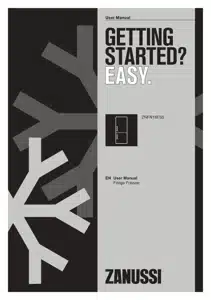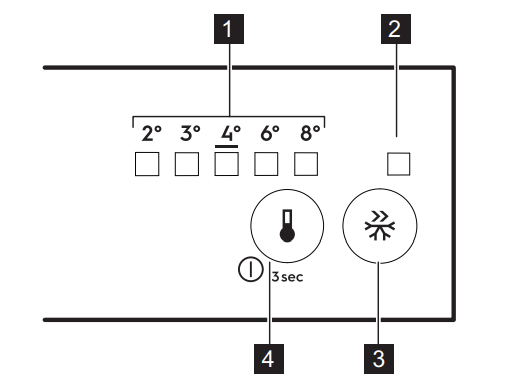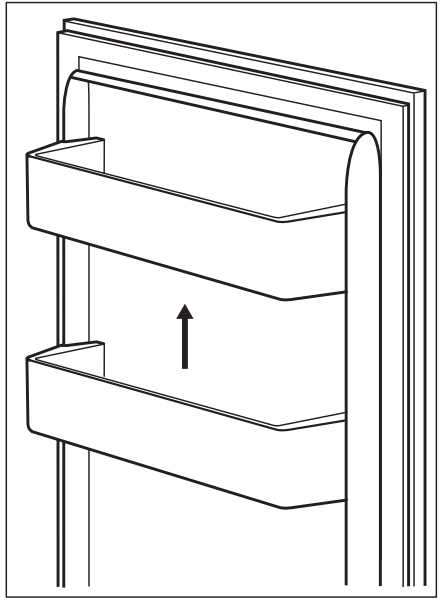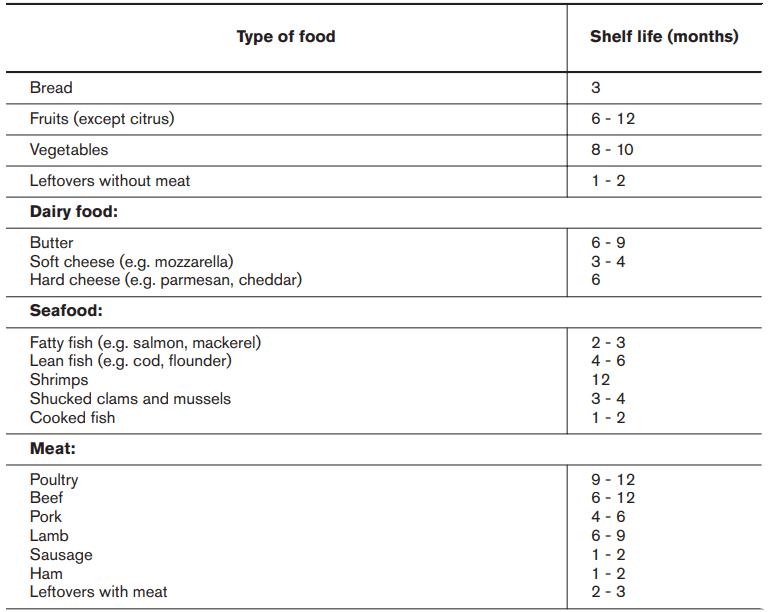Documents: Go to download!
User Manual
- User Manual - (English)
- Specification Sheet - (English)
- Energy Label - (English)
- Product information sheet - (English)

- CONTROL PANEL
- DAILY USE
- HINTS AND TIPS
- CARE AND CLEANING
- TROUBLESHOOTING
Table of contents
User Manual Fridge Freezer
CONTROL PANEL

- Temperature indicator LED
- FastFreeze indicator
- FastFreeze button
- Temperature regulator ON/OFF button
SWITCHING ON
- Insert the plug into the wall socket.
- Touch the temperature regulator button if all LED indicators are off.
SWITCHING OFF
Keep touching the temperature regulator button for 3 seconds.
All indicators light off
TEMPERATURE REGULATION
To operate the appliance, touch the temperature regulator until the LED corresponding to the required temperature lights up. Selection is progressive, varying from 2°C to 8°C. Recommended setting is 4°C.
1. Touch temperature regulator.
Current temperature indicator blinks. Any time you touch the temperature regulator, the setting moves by one position. The corresponding LED blinks for a while.
2. Touch the temperature regulator until the required temperature is selected.
The set temperature will be reached within 24 hours. After a power failure the set temperature remains stored.
FAST FREEZE FUNCTION
The FastFreeze function is used to perform prefreezing and fast freezing in sequence in the freezer compartment. This function accelerates the freezing of fresh food and, at the same time, protects food products already stored in the freezer compartment from undesirable warming.
To freeze fresh food activate the FastFreeze function at least 24 hours before placing the food to complete pre-freezing.
To activate FastFreeze function press the FastFreeze button. The FastFreeze indicator switches on.
This function stops automatically after 52 hours.
It is possible to deactivate the function at any time by pressing FastFreeze button again. The FastFreeze indicator switches off.
DOOR OPEN ALARM
If the fridge door is left open for approximately 5 minutes, the sound is on.
During the alarm the sound can be muted by pressing any button. The sound switches off automatically after around one hour to avoid disturbing.
The alarm deactivates after closing the door.
DAILY USE
POSITIONING THE DOOR SHELVES
To permit storage of food packages of various sizes, the door shelves can be placed at different heights.
- Gradually pull the shelf up until it comes free.
- Reposition as required.

MOVABLE SHELVES
The walls of the refrigerator are equipped with a series of runners so that the shelves can be positioned as desired.

Do not move the glass shelf above the vegetable drawer to ensure correct air circulation.
VEGETABLE DRAWERS
There are special drawers in the bottom part of the appliance suitable for storage of fruits and vegetables.
FREEZING FRESH FOOD
The freezer compartment is suitable for freezing fresh food and storing frozen and deep-frozen food for a long time.
To freeze fresh food activate the FastFreeze function at least 24 hours before placing the food to be frozen in the freezer compartment.
Store the fresh food evenly distributed in all compartments or drawers.
The maximum amount of food that can be frozen without adding other fresh food during 24 hours is specified on the rating plate (a label located inside the appliance).
When the freezing process is complete, the appliance automatically returns to the previous temperature setting (see "FastFreeze Function").
In this condition, the temperature inside the refrigerator might change slightly.
STORAGE OF FROZEN FOOD
When activating an appliance for the first time or after a period out of use, before putting the products in the compartment let the appliance run at least 3 hours with the FastFreeze function switched on.
The freezer drawers ensure that it is quick and easy to find the food package you want. If large quantities of food are to be stored, remove all drawers, except for the bottom drawer which needs to be in place to provide good air circulation. Keep the food no closer than 15 mm from the door.
CAUTION! In the event of accidental defrosting, for example due to a power failure, if the power has been off for longer than the value shown on rating plate under "rising time", the defrosted food must be consumed quickly or cooked immediately then cooled and then re-frozen.
THAWING
Deep-frozen or frozen food, prior to being consumed, can be thawed in the refrigerator or inside a plastic bag under cold water.
This operation depends on the time available and on the type of food. Small pieces may even be cooked still frozen.
ICE-CUBE PRODUCTION
This appliance is equipped with one or more trays for the production of ice-cubes.
Do not use metallic instruments to remove the trays from the freezer.
- Fill these trays with water.
- Put the ice trays in the freezer compartment.
HINTS AND TIPS
HINTS FOR ENERGY SAVING
• Freezer: The internal configuration of the appliance is the one that ensures the most efficient use of energy.
• Fridge: Most efficient use of energy is ensured in the configuration with the drawers in the bottom part of the appliance and shelves evenly distributed. Position of the door bins does not affect energy consumption.
• Do not open the door frequently or leave it open longer than necessary.
• Freezer: The colder the temperature setting, the higher the energy consumption.
• Fridge: Do not set too high temperature to save energy unless it is required by the characteristics of the food.
• If the ambient temperature is high and the temperature control is set to low temperature and the appliance is fully loaded, the compressor may run continuously, causing frost or ice formation on the evaporator. In this case, set the temperature control toward higher temperature to allow automatic defrosting and to save energy this way.
• Ensure a good ventilation. Do not cover the ventilation grilles or holes.
HINTS FOR FREEZING
• Activate FastFreeze function at least 24 hours before placing the food inside the freezer compartment.
• Before freezing wrap and seal fresh food in: aluminium foil, plastic film or bags, airtight containers with lid.
• For more efficient freezing and thawing divide food into small portions.
• It is recommended to put labels and dates on all your frozen food. This will help to identify foods and to know when they should be used before their deterioration.
• The food should be fresh when being frozen to preserve good quality. Especially fruits and vegetables should be frozen after the harvest to preserve all of their nutrients.
• Do not freeze bottles or cans with liquids, in particular drinks containing carbon dioxide - they may explode during freezing.
• Do not put hot food in the freezer compartment. Cool it down at room temperature before placing it inside the compartment.
• To avoid increase in temperature of already frozen food, do not place fresh unfrozen food directly next to it. Place food at room temperature in the part of the freezer compartment where there is no frozen food.
• Do not eat ice cubes, water ices or ice lollies immediately after taking them out of the freezer. Risk of frostbites.
• Do not re-freeze defrosted food. If the food has defrosted, cook it, cool it down and then freeze it.
HINTS FOR STORAGE OF FROZEN FOOD
• Freezer compartment is the one marked with .
.
• The medium temperature setting ensures good preservation of frozen food products. Higher temperature setting inside the appliance may lead to shorter shelf life.
• The whole freezer compartment is suitable for storage of frozen food products.
• Leave enough space around the food to allow air to circulate freely.
• For adequate storage refer to food packaging label to see the shelf life of food.
• It is important to wrap the food in such a way that prevents water, humidity or condensation from getting inside.
SHOPPING TIPS
After grocery shopping:
• Ensure that the packaging is not damaged - the food could be deteriorated. If the package is swollen or wet, it might have not been stored in the optimal conditions and defrosting may have already started.
• To limit the defrosting process buy frozen goods at the end of your grocery shopping and transport them in a thermal and insulated cool bag.
• Place the frozen foods immediately in the freezer after coming back from the shop.
• If food has defrosted even partially, do not refreeze it. Consume it as soon as possible.
• Respect the expiry date and the storage information on the package.
SHELF LIFE FOR FREEZER COMPARTMENT

HINTS FOR FRESH FOOD REFRIGERATION
• Good temperature setting that ensures preservation of fresh food is a temperature less than or equal to +4°C. Higher temperature setting inside the appliance may lead to shorter shelf life of food.
• Cover the food with packaging to preserve its freshness and aroma.
• Always use closed containers for liquids and for food, to avoid flavours or odours in the compartment.
• To avoid the cross-contamination between cooked and raw food, cover the cooked food and separate it from the raw one.
• It is recommended to defrost the food inside the fridge.
• Do not insert hot food inside the appliance. Make sure it has cooled down at room temperature before inserting it.
• To prevent food waste the new stock of food should always be placed behind the old one.
HINTS FOR FOOD REFRIGERATION
• Fresh food compartment is the one marked (on the rating plate) with  .
.
• Meat (all types): wrap in a suitable packaging and place it on the glass shelf above the vegetable drawer. Store meat for at most 1-2 days.
• Fruit and vegetables: clean thoroughly (eliminate the soil) and place in a special drawer (vegetable drawer).
• It is advisable not to keep the exotic fruits like bananas, mangos, papayas etc. in the refrigerator.
• Vegetables like tomatoes, potatoes, onions, and garlic should not be kept in the refrigerator.
• Butter and cheese: place in an airtight container or wrap in an aluminium foil or a polythene bag to exclude as much air as possible.
• Bottles: close them with a cap and place them on the door bottle shelf, or (if available) on the bottle rack.
• Always refer to the expiry date of the products to know how long to keep them.
CARE AND CLEANING
CLEANING THE INTERIOR
Before using the appliance for the first time, the interior and all internal accessories should be washed with lukewarm water and some neutral soap to remove the typical smell of a brand-new product, then dried thoroughly.
CAUTION! Do not use detergents, abrasive powders, chlorine or oilbased cleaners as they will damage the finish.
CAUTION! The accessories and parts of the appliance are not suitable for washing in a dishwasher.
PERIODIC CLEANING
The equipment has to be cleaned regularly:
- Clean the inside and accessories with lukewarm water and some neutral soap.
- Regularly check the door seals and wipe them clean to ensure they are clean and free from debris.
- Rinse and dry thoroughly.
DEFROSTING OF THE REFRIGERATOR
Frost is automatically eliminated from the evaporator of the refrigerator compartment during normal use. The defrost water drains out through a trough into a special container at the back of the appliance, over the motor compressor, where it evaporates.
It is important to periodically clean the defrost water drain hole in the middle of the refrigerator compartment channel to prevent the water overflowing and dripping onto the food inside.
For this purpose use the tube cleaner provided with the appliance.

DEFROSTING OF THE FREEZER
 CAUTION! Never use sharp metal tools to scrape off frost from the evaporator as you could damage it. Do not use a mechanical device or any artificial means to speed up the thawing process other than those recommended by the manufacturer
CAUTION! Never use sharp metal tools to scrape off frost from the evaporator as you could damage it. Do not use a mechanical device or any artificial means to speed up the thawing process other than those recommended by the manufacturer
 About 12 hours prior to defrosting set a lower temperature in order to build up sufficient chill reserve in case of any interruption in operation.
About 12 hours prior to defrosting set a lower temperature in order to build up sufficient chill reserve in case of any interruption in operation.
A certain amount of frost will always form on the freezer shelves and around the top compartment. Defrost the freezer when the frost layer reaches a thickness of about 3-5 mm
- Switch off the appliance or pull out electrical plug from the wall socket.
- Remove any stored food and put it in a cool place. CAUTION! A temperature rise of the frozen food packs during defrosting may shorten their safe storage life. Do not touch frozen goods with wet hands. Hands can freeze to the goods.
- Leave the door open. Protect the floor from the defrosting water e.g. with a cloth or a flat vessel.
- In order to speed up the defrosting process, place a pot of warm water in the freezer compartment. In addition, remove pieces of ice that break away before defrosting is complete. Use the supplied ice scraper for this purpose.
- When defrosting is complete, dry the interior thoroughly. Keep the ice scraper for the future use.
- Switch on the appliance and close the door.
- Set the temperature regulator to obtain the maximum coldness and run the appliance for at least 3 hours using this setting.
Only after this time put the food back into the freezer compartment.
PERIOD OF NON-OPERATION
When the appliance is not in use for long period, take the following precautions:
- Disconnect the appliance from electricity supply.
- Remove all food.
- Defrost the appliance.
- Clean the appliance and all accessories
- Leave the doors open to prevent unpleasant smells.
TROUBLESHOOTING
WHAT TO DO IF...
| Problem | Possible cause | Solution |
| The appliance does not operate. | The appliance is switched off. | Switch on the appliance |
| The mains plug is not connected to the mains socket correctly. | Connect the mains plug to the mains socket correctly. | |
| There is no voltage in the mains socket. | Connect a different electrical appliance to the mains socket. Contact a qualified electrician. | |
| The appliance is noisy. | The appliance is not supported properly. | Check if the appliance stands stable. |
| Acoustic or visual alarm is on. | The cabinet has been recently switched on. | Refer to "Door Open Alarm" or "High Temperature Alarm". |
| The temperature in the appliance is too high. | Refer to "Door Open Alarm" or "High Temperature Alarm". | |
| The door is left open. | Close the door. | |
| The compressor operates continually. | Temperature is set incorrectly. | Refer to "Control Panel" chapter. |
| Many food products were put in at the same time. | Wait a few hours and then check the temperature again. | |
| The room temperature is too high. | Refer to "Installation" chapter. | |
| Food products placed in the appliance were too warm. | Allow food products to cool to room temperature before storing. | |
| The door is not closed correctly. | Refer to "Closing the door" section. | |
| The FastFreeze function is switched on. | Refer to "FastFreeze function" section. | |
| The compressor does not start immediately after pressing the "FastFreeze", or after changing the temperature. | The compressor starts after a period of time. | This is normal, no error has occurred. |
| Door is misaligned or interferes with ventilation grill. | The appliance is not levelled. | Refer to installation instructions. |
| Door does not open easily. | You attempted to re-open the door immediately after closing. | Wait a few seconds between closing and re-opening of the door. |
| The lamp does not work. | The lamp is in stand-by mode. | Close and open the door. |
| The lamp is defective. | Contact the nearest Authorized Service Centre. | |
| There is too much frost and ice. | The door is not closed correctly. | Refer to "Closing the door" section |
| The gasket is deformed or dirty. | Refer to "Closing the door" section. | |
| Food products are not wrapped properly. | Wrap the food products better. | |
| Temperature is set incorrectly. | Refer to "Control Panel" chapter. | |
| Appliance is fully loaded and is set to the lowest temperature. | Set a higher temperature. Refer to "Control Panel" chapter. | |
| Temperature set in the appliance is too low and the ambient temperature is too high. | Set a higher temperature. Refer to "Control Panel" chapter. | |
| Water flows on the rear plate of the refrigerator. | During the automatic defrosting process, frost melts on the rear plate. | This is correct. |
| There is too much condensed water on the rear wall of the refrigerator. | Door was opened too frequently. | Open the door only when necessary. |
| Door was not closed completely. | Make sure the door is closed completely | |
| Stored food was not wrapped. | Wrap food in suitable packaging before storing it in the appliance | |
| Water flows inside the refrigerator. | Food products prevent the water from flowing into the water collector. | Make sure that food products do not touch the rear plate. |
| The water outlet is clogged. | Clean the water outlet. | |
| Water flows on the floor. | The melting water outlet is not connected to the evaporative tray above the compressor. | Attach the melting water outlet to the evaporative tray. |
| Temperature cannot be set. | The "FastFreeze function" is switched on. | Switch off "FastFreeze function" manually, or wait until the function deactivates automatically to set the temperature. Refer to "FastFreeze function" section. |
| The temperature in the appliance is too low/too high. | The temperature is not set correctly. | Set a higher/lower temperature. |
| The door is not closed correctly. | Refer to "Closing the door" section. | |
| The food products' temperature is too high. | Let the food products temperature decrease to room temperature before storage. | |
| Many food products are stored at the same time. | Store less food products at the same time. | |
| The thickness of the frost is greater than 4-5 mm. | Defrost the appliance. | |
| The door has been opened often. | Open the door only if necessary. | |
| The FastFreeze function is switched on. | Refer to "FastFreeze function" section | |
| There is no cold air circulation in the appliance. | Make sure that there is cold air circulation in the appliance. Refer to "Hints and Tips" chapter. | |
| Some specific surfaces inside the fridge compartment are warmer at some times. | This is a normal state. | |
| Temperature setting LEDs flash at the same time. | An error has occurred in measuring the temperature. | Contact the nearest Authorised Service Centre. The cooling system will continue to keep food products cold, but temperature adjustment will not be possible. |
REPLACING THE LAMP
The appliance is equipped with a longlife LED interior light.
Only service is allowed to replace the lighting device. Contact your Authorised Service Centre.
CLOSING THE DOOR
- Clean the door gaskets.
- If necessary, adjust the door. Refer to installation instructions.
- If necessary, replace the defective door gaskets. Contact the Authorised Service Centre.
See other models: ZNNN18FS5 ZNLN14FS ZNLN18FS1 ZNTN19ES1 ZCAN26FW1
